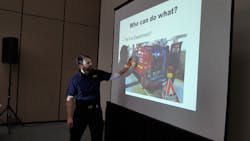FHWorld16: A Look at Swedish Rapid Response Vehicles
SAN DIEGO, Calif. – When chief officers in Sweden decided firefighters needed to do more with less, fast response vehicles were deployed. To make them work, different methods of firefighting and delivery of services had to be developed.
Lars Ågerstrand, battalion chief, Värnamo Fire & Rescue, Sweden, taught a class at Firehouse World describing what kinds of rigs were selected and how the fire service in his homeland put them to work. The title of his class was “Fast Response Units for Effective Firefighting (An International Perspective).”
“With more rapid response vehicles around, it’s like having mobile fire stations all over the place,” Ågerstrand said. “With most fires, if we get there fast enough, they can be dealt with very small means.”
Ågerstrand said the smaller vehicles have compressed air foam systems (CAFS) and a Swedish-based “Cobra” fire suppression system with capabilities of delivering about 15 gpm at 4,000 psi. The Cobras are great at producing small water particles which create steam for very effective fire knock down making suppression and mop up easier, he said.
“The concept is to keep the fire small until the bigger resources arrive,” Ågerstrand said.
Ågerstrand said trained firefighters with a mini response vehicle can do a lot of work. He explained some fire science to back up the need for door control, to limit air to the fire and keep temperatures cooler.
“Keep the door closed, you’ll have less heat,” Ågerstrand said. “The higher the temperature goes up, everything gets worse. As the temperature goes down, everything gets better.
With door control in place, Ågerstrand a dry chemical extinguisher proves quite effective at knocking down a room and contents fire, Ågerstrand said.
“It will steal energy from the flames,” Ågerstrand said. “It’s a positive thing, but it’s not a way to extinguish fire. It will buy yourself some time.”
Ågerstrand said it might be a good idea for an officer or the chief doing a 360-degree walk around of the fire to carry a dry chemical fire extinguisher, saying that a dry chemical extinguisher is eight times more effective than straight water.
“When the powder mixes in the gases, it is impossible to burn,” Ågerstrand said, adding they can be used in attic fires and basement fires.
“It’s just to take the temperature down and buy some time,” Ågerstrand said.
Going hand in hand with the concept of using fire extinguishers for early firefighting efforts, Ågerstrand said it might be wise for firefighters to consider finding people outside the fire departments to become rapid response fire fighters. People like police officers, security guards, home care units, maintenance workers and cleaners are excellent candidates to train in extinguisher use and have them readily available, perhaps even carried by those individuals.
Civilians with a cell phone app alerting them to a fire around the corner is also something to consider, Ågerstrand said.
“We can do a ton with a portable dry chem extinguisher,” Ågerstrand said. “We need to consider the fire service is not just the fire service. It is something bigger.”
Ågerstrand said there are two ways to rescue people from fires and both are very different in execution. The first way is to go in as quickly as possible with high heat, dense smoke and hostile conditions, grab the victim and exit. The second way is to put a knock on the fire and ventilate the structure for better visibility, he said.
He made an analogy about children playing in a cornfield that scatter for hide and seek just before a tractor enters the field to harvest the corn.
“You can go into the cornfield and look for the children one by one, or you can run to the farmer and ask him to stop the tractor,” he said. “Both are achieving the same objectives. They’re just done in two different ways.”
A rapid response vehicle will give fire crews options to get the fire out faster, he said.
“This is not designed to replace bigger fire trucks,” Ågerstrand said. “This is just an add-on to improve our response.”
He also said the smaller apparatus can also be more fun.
“When you arrive you’re like Rambo,” Ågerstrand said. “You have to find different ways to fight fire, so you’ll have to find the appropriate tool in the appropriate time.”
More from Firehouse World 2016
- Photos: Day 1 - Future Firefighter Program
- FHWorld16: Firehouse Ambassadors Get Lessons in Values
- FHWorld16: Fireground Air Management - A US/UK Perspective
- FHWorld16: Building a Robust Fire Dynamics Training Program
- FHWorld16: The Halligan Is a Valuable Tool on the Fireground
- FHWorld16: Sendelbach Poses Challenge to Fire Service
- FHWorld16: Chief Hood Says It's 'Time to Own It'
- FHWorld16: Leading Health Risks on the Modern Fireground
- FHWorld16: An International Look at Firefighting
- Photos: Day 2 - Firehouse World 2016
- FHWorld16: Strategies & Tactics for Residential Attic Fires
- FHWorld16: Safety in the Decision-Making Process
- FHWorld16: Trust Between Officers, Chiefs Critical to Fireground Operations
- FHWorld16: Weathering Organizational Change Takes the Efforts of Many
- FHWorld16: Fresno Fire Chief Donis Addresses Cortland Incident
- FHWorld16: Each Firefighter Controls Integrity, Virtues
- FHWorld 16: Baltimore Chiefs Discuss Response, Challenges During Riots
- FHWorld16: A Look at Swedish Rapid Response Vehicles
